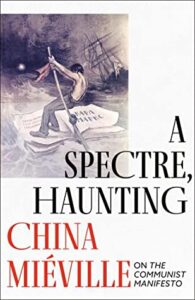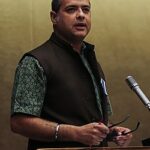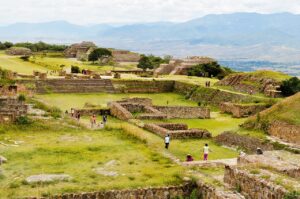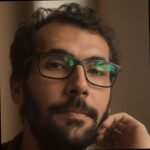 “The Communist Manifesto” is one of the most widely read political documents in the history of the world. It influenced millions of people against capitalist oppression and toward a more just and humane social order. It is also a brilliant display of literary and poetic expression by its author, the German revolutionary philosopher Karl Marx, which few, if any, political commentators since have been able to match. But is “The Communist Manifesto” politically relevant today? The renowned British and New York Times-bestselling author of “weird fiction” and non-fiction books China Miéville thinks so, which is why he wrote his latest book, A Spectre, Haunting: On the Communist Manifesto, published in May 2022 by Haymarket Books. The book, incidentally, has been described — correctly so, I might add — as “a lyrical introduction and a spirited defense of the modern world’s most influential political document.”
“The Communist Manifesto” is one of the most widely read political documents in the history of the world. It influenced millions of people against capitalist oppression and toward a more just and humane social order. It is also a brilliant display of literary and poetic expression by its author, the German revolutionary philosopher Karl Marx, which few, if any, political commentators since have been able to match. But is “The Communist Manifesto” politically relevant today? The renowned British and New York Times-bestselling author of “weird fiction” and non-fiction books China Miéville thinks so, which is why he wrote his latest book, A Spectre, Haunting: On the Communist Manifesto, published in May 2022 by Haymarket Books. The book, incidentally, has been described — correctly so, I might add — as “a lyrical introduction and a spirited defense of the modern world’s most influential political document.”
Miéville studied at Cambridge University and received a Ph.D. in international relations from the London School of Economics. He has published scores of highly acclaimed fiction works, such as King Rat (1998), which was nominated for both the International Horror Guild and Bram Stoker Awards for best first novel; Perdido Street Station (2000), which won the 2001 Arthur C. Clarke award for best science fiction and a 2001 British Fantasy Award; Iron Council (2004), winner of the Arthur C. Clarke award and the Locus Award for Best Fantasy Novel; The City & the City (2009), a further winner of an Arthur C. Clarke award, Hugo Award and World Fantasy Award for Best Novel; and The Last Days of a New Paris (2016). A self-proclaimed Marxist, Miéville has also published Between Equal Rights: A Marxist Theory of International Law and October: The Story of the Russian Revolution.
In this exclusive interview for Truthout, Miéville discusses his latest book, why it’s still important to engage with “The Communist Manifesto” and why we must approach ecological catastrophe with radical theory.
C. J. Polychroniou: “The Communist Manifesto,” originally known as the “Manifesto of the Communist Party,” was written by Karl Marx with the assistance of Friedrich Engels and published in London on February 21, 1848. Its original aim was to serve “as a complete theoretical and practical party program” for the Communist League, but ultimately became the principal political pamphlet for the European communist parties in the 19th and 20th centuries. It is also widely recognized as one of the most important and influential political documents in the history of the world. Of course, history has taken a very different route from that envisioned by Marx and Engels. True, communism (or some variant of it!) was tried out in different parts of the world, but capitalism still reigns supreme. With that in mind, what prompted you to write a book on “The Communist Manifesto” in the second decade of the 21st century? Historical curiosity or political relevance?
China Miéville: There’s no necessary contradiction between the two, of course. I do think that the manifesto should be an object of historical curiosity to anyone interested in the shaping of the modern world, and/or of great and historical ideas. And to that extent, I’m well aware that plenty of potential readers of A Spectre, Haunting will be highly skeptical about communism in any form, and thus of the modern applicability of the book.
Part of the argument is that it is still worth engaging with the manifesto. To preempt the second half of this answer, I disagree with that sense that it’s a purely historical curiosity, for reasons that I try to make clear in the book. But I’ve also long been frustrated by the profoundly dunderheaded and either bad faith or ignorant (or both) nature of the so-called debates around the manifesto. One of the ideas of this book is to say precisely to people who do not see the pamphlet as politically relevant that the great majority of the arguments usually adduced for that position are just intellectually lazy and embarrassing, and that surely it is critics who should give their intellectual and political opponents the courtesy of taking them on at their strongest, and with the most curious and generous and engaged reading, rather than airily reciting completely unthinking bromides and nostrums. I hope if I were to pronounce on a book with which I profoundly disagreed, I would try to engage with it seriously.
All of which is to say that I hope A Spectre, Haunting invites an engagement from people who profoundly disagree with me, and with the manifesto, at a serious, interesting and worthy level. In other words, even if you don’t find anything politically relevant in the manifesto, you can’t, surely, dismiss its historical and social importance, and if the book does nothing else than to plead for a more serious discussion of it at that level, I would be pleased. Because — again, as I try to say and illustrate in A Spectre, Haunting, and with some honorable exceptions — most of the discussions of the manifesto from its critics, including very celebrated critics and those who, I think, should know far better, is based on piss-poor and miserly reading.
Of course, on top of that, I absolutely do think that the manifesto remains politically relevant. Indeed, inspirational. Not that I have, or anyone should have, an uncritical or dogmatic relationship to it. In the book, I try to make clear the various ways in which, and issues on which, I think the manifesto is inadequate, or contradictory, or simply wrong. But for me, the manifesto read as it deserves to be read, flawed and rushed and partial as it is, is a work of incredible political importance — as well as great literary urgency and beauty.
Every day, capitalism proves that it is absolutely indifferent to human flourishing, or life, and therefore it really shouldn’t be a surprise that so many of the grotesque and monstrous phenomena of our society — inequality, racism, misogyny, imperialism, ecological catastrophe, mass extinction, mass unnecessary death — are inextricable from capitalism. The demand for a system that prioritizes human need over profit is a demand for the end of capitalism. We can debate what that might look like, but if we take seriously the idea that the only way to get to a world fit to live in is to get beyond capitalism, we have to move beyond the “common sense” — which is to say, the deadening propaganda — that it is “obviously” impossible to have anything other than capitalism. The manifesto’s unremitting insistence on the dynamics of class history that got us here, and its ruthless denaturalizing and questioning of supposedly eternal truths, all in the service of liberation, is profoundly important.
“Workers of All Countries, Unite” is one of the most fundamental political slogans of “The Communist Manifesto.” Was this a call for world revolution or merely political rhetoric? Indeed, there is an entire genre of political writing devoted to the idea that Marx was actually in favor of restricting immigration (Irish immigration, as a case in point) because it was driving down wages for (English) workers. Do you have any thoughts on this matter? Would Marx be favoring immigration restrictions today?
It was certainly not “mere” rhetoric, though it was part of a rhetorical masterwork. But it was rhetoric deployed as part of — whether you agree with it or not — an absolutely sincere political project, a commitment to world revolution. On the vexed question of Marx and immigration: Mature Marx was absolutely and explicitly clear that English workers’ racism against Irish workers was a profound plank in their own oppression and had to be overcome before political liberation could be pursued. In addition, he and Engels were unstintingly suspicious of the bourgeois state, which of course is the proponent, perpetrator and police of immigration controls. I think Marx and Engels would treat immigration restrictions today with the contempt and suspicion that, as tools predicated on and bolstering racism, and that undermine the international solidarity of the working class — which, the manifesto insists, “has no country” — they deserve. That said, it’s worth stressing that I’m very suspicious of the kind of apologetic theology approach to Marxism that tries to derive a political position today from what Marx would or would not have thought. First of all, the judgment of what he “would have thought” (which has a discomfiting hagiographical ring to it) always involves an act of historical translation at very best, and violence at worst: because context is everything. Fredric Jameson is right: always historicize. Secondly, because it’s hardly surprising that one could find in Marxism as a system an indispensable tool for analysis, and also disagree with Marx — even if we could be confident in what he would say — in particular concrete instances. The key points are what the truth is, and what is the best political approach in principle and strategically and tactically. Without question, finding as I do such great resources in the Marxist tradition, I think that Marx’s opinions are crucial data with regard to that, but it’s perfectly possible to cleave to the method and tradition, and yet to disagree with Marx on this or that.
As noted earlier, communism was tried out in different parts of the world throughout the 20th century. From your own perspective, was Marx’s vision of communism realized in any form or shape under “actually existing socialism” regimes?
Simply put, no. That’s not an adequate answer, of course. And to be clear, though I do go into this a little bit in my book, in-depth of the “actually existing socialisms” is some way beyond its remit, so I’m not pretending to have made a conclusive argument on this issue. What I do want to do is stress what I think should be a given starting point for any good-faith debate, but which absolutely isn’t, which is that seeing those regimes as “communist” simply because they say so is absolutely absurd. It’s absurd whether that’s from the side of critics, who use it to argue that communism is inevitably oppressive, or from the side of apologists and partisans, who take the side of those regimes out of some commitment to something called “communism.” Again, I make no bones about the fact that I find “The Communist Manifesto” to be an inspirational text, but even if you are purely and deeply critical of it, it is simply embarrassingly ignorant not to engage with the fact that there have, for over a hundred years, been debates within Marxism over exactly what the shape of political fidelity to the manifesto should look like, and indeed over the directions taken by the various regimes traceable to the Russian Revolution of 1917, in one form or another. Whatever you think of any of the various sides in any of these debates, to argue in ignorance of all those incredibly critical communist currents implacably set against the dead hand of Stalinism just won’t do.
I try to make the case in the book that inextricable from the vision in the manifesto is a grassroots democratic control of society, a democracy infinitely greater than any of the etiolated versions we’ve hitherto seen. And that the structural antipathy of actually existing socialism — to varying degrees, to be sure, and taking highly different shapes — sets it against the vision of the manifesto. I try to at least advert to the specific historical circumstances that I think gave rise to this tragedy. And, to repeat myself, to have a good-faith debate about whether or not my analysis is correct is one thing, and I welcome it, including with those profoundly opposed to my position. But simply to gesture vaguely at Stalinism and say that it disproves the manifesto is just intellectually embarrassing and, again, incurious.
Be that as it may, Marx’s vision of a future social and economic order beyond capitalism has come under criticism by ecological economists because it is supposedly driven by technological determinism and human domination over nature. In sum, Marx’s vision of communism as a form of human development is deemed unsustainable in the eyes of those who embrace the “degrowth” perspective due to its treatment of natural conditions as effectively unlimited. Personally, I find this criticism quite puzzling since both Marx and Engels treated humans and nature as “not separate things” and even defined communism as the “unity of being of man with nature.” Do you agree with those who view “The Communist Manifesto” as embracing an essentially anti-ecological view?
This is one of those instances in which I take a position somewhat analogous to Victor Serge’s position with regard to the Bolsheviks and Stalinism (to echo your previous question). He said: “It is often said that ‘the germ of all Stalinism was in Bolshevism at its beginning.’ Well, I have no objection. Only, Bolshevism also contained many other germs, a mass of other germs, and those who lived through the enthusiasm of the first years of the first victorious socialist revolution ought not to forget it. To judge the living man by the death germs which the autopsy reveals in the corpse — and which he may have carried in him since his birth — is that very sensible?”
I agree with you, in that a rigorous analysis of Marx’s and Engels’s position does indeed stress their view of the false distinction between nature and humanity, and to that extent you could even say nature and society. I think there is much fertile ground for an ecologically conscious democratic communism in notions such as the fulfillment of “species-being,” and in Marx’s conception of the “irreparable rift in the interdependent process of social metabolism” under capitalism, that John Bellamy Foster calls the “metabolic rift,” and the ecological catastrophe concomitant on it. All of which said, I think there are also germs of a somewhat less nuanced Prometheanism in the manifesto. (I’m not at all averse to a Prometheanism worthy of the name, but many tendencies so-glossed lean toward a kind of vulgar productivism.) The manifesto’s visions of a post-scarcity classless society are bracing and inspiring and convincing to me. But they can be — not must be, but can be and have been — interpreted in ways that, from my perspective, are predicated on a vaguely utopian position about the social good of “human ingenuity” nebulously inextricable from productivism, as manifested in what is sometimes called ecomodernism (though I wish it were another label).
This is an argument that I and my comrades in the Salvage Collective engaged with in our short book The Tragedy of the Worker, and the perspective therein informs this book on the manifesto. Relatedly, I think any thinking inspired by the manifesto that understates the task of repair and salvage necessary in any post-capitalist world, given the ecological depredations of capitalism and the dynamics of ecological crisis already in place, is not being realistic. What that doesn’t mean is either the stasis of despair — I think despair gets a bad rap, but I’m pro what John Berger called “undefeated despair” rather than surrender — or a belief in the necessity of some ascetic communism, against which the manifesto explicitly set itself. And I think it was right to do so, on ethical and analytical grounds.
One of the few positive things about the recent years is that a sense of the pressing nature of ecological catastrophe is clear and present, and embedding into radical theory in a very positive way. So, to return to your question: No, I certainly don’t think “The Communist Manifesto” is intrinsically ecologically vulgar or worse. But nor do I think that, in this epoch, we can do without posing such questions explicitly as part of a radical left agenda, and mindful that the work of repair capitalism will bequeath us will be enormous.
Conversely, I should add, I think any attempt to forge an ecological politics that is not predicated on an analysis that capitalism’s prioritization of profit over need, and the urgent human necessity of moving beyond capitalism, to a true democracy of grassroots control, is on a hiding to nothing.
Source: https://truthout.org/
C.J. Polychroniou is a political scientist/political economist, author, and journalist who has taught and worked in numerous universities and research centers in Europe and the United States. Currently, his main research interests are in U.S. politics and the political economy of the United States, European economic integration, globalization, climate change and environmental economics, and the deconstruction of neoliberalism’s politico-economic project. He is a regular contributor to Truthout as well as a member of Truthout’s Public Intellectual Project. He has published scores of books and over 1,000 articles which have appeared in a variety of journals, magazines, newspapers and popular news websites. Many of his publications have been translated into a multitude of different languages, including Arabic, Chinese, Croatian, Dutch, French, German, Greek, Italian, Japanese, Portuguese, Russian, Spanish and Turkish. His latest books are Optimism Over Despair: Noam Chomsky On Capitalism, Empire, and Social Change (2017); Climate Crisis and the Global Green New Deal: The Political Economy of Saving the Planet (with Noam Chomsky and Robert Pollin as primary authors, 2020); The Precipice: Neoliberalism, the Pandemic, and the Urgent Need for Radical Change (an anthology of interviews with Noam Chomsky, 2021); and Economics and the Left: Interviews with Progressive Economists (2021).





